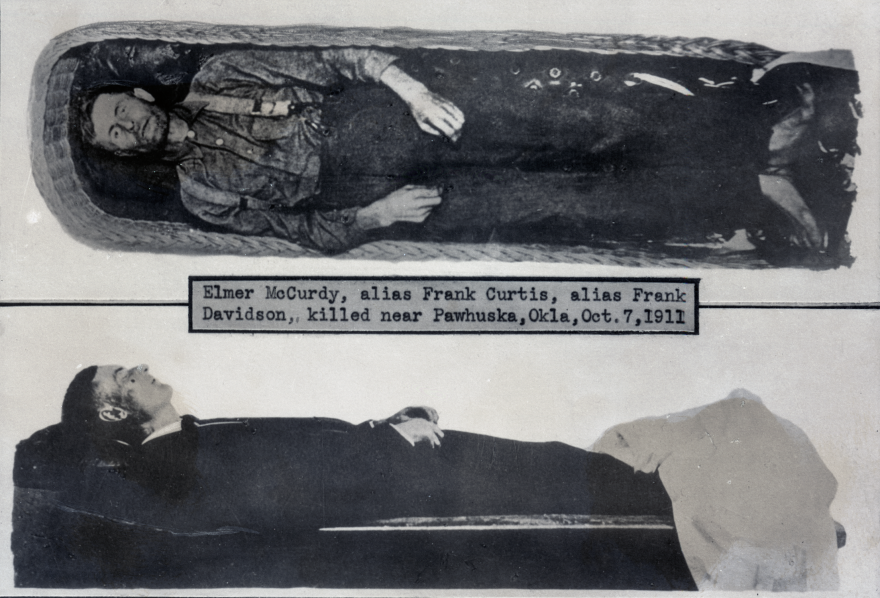One windy morning, I took a stroll through Summit View Cemetery in Guthrie.
As I entered a section of the cemetery called Boot Hill, I noticed the graves of several outlaws like Bill Doolin, Bert Casey and Richard “Little Dick” West.
These men have gone down in Oklahoma history as accomplished outlaws, but KGOU’s General Manager Dick Pryor said not every outlaw that passed through the state is known for this reason.
“Some became famous because they were really good at what they did,” Pryor said. “Others became famous because they were not.”
Pryor wonders who is the worst outlaw that became famous in Oklahoma?
Many consider that outlaw to be Elmer McCurdy.
Even though he is buried among infamous outlaws on Boot Hill, most people do not remember McCurdy’s failed robbery attempts. Instead, he is remembered for an unconventional reason: for what happened to his body after he died.
McCurdy’s ‘Misadventures’
McCurdy, who was from Maine, was among millions of people on the move, looking for work in America during the economic crisis around the turn of the 19th [into the 20th] century.
“He was always this drifter, always an outsider, and even right up to the end,” said Mark Svenvold, the author of “Elmer McCurdy: The Misadventures In Life and Afterlife of an American Outlaw.”
McCurdy joined the U.S. Army, where he developed at least a basic understanding of how to use explosives. Svenvold said he used this training to try to rob banks. Emphasis on try.
“He was a nitroglycerin guy… but sort of comically inept actually at doing the job,” Svenvold said. “There was a bank. They blew up the safe, and the heat of the explosion fuzed the coins to the lining in the inner walls of the safe.”
McCurdy then ended up in Oklahoma, where he attempted to rob a train in 1911.
“The Osage Indians were incredibly wealthy because of oil revenues and because of a number of other things,” said Svenvold. “What happened is every fiscal quarter, a train would come into Pawhuska loaded with cash. It was distributed to the Osages. And so payment days, it attracted all sorts of people looking for some easy money.”
Except McCurdy accidentally robbed the wrong train. Rather than leaving with $400,000, he ended up with $45 and whiskey.
This led to McCurdy being killed in his early 30s during a shoot out with a sheriff's posse.
“The Thousand-Year-Old Man”
A funeral home in Pawhuska took possession of McCurdy’s body, awaiting word from the next of kin. In the meantime, the funeral home owner embalmed his body as a means of preservation, according to Svenvold.
“It was a kind of thing that was done to outlaws to display them,” Svenvold said. “The Johnson Funeral Home would charge people if they wanted to come and take a look at the famous outlaw, now mummified.”

Visitors paid five cents, which was placed in McCurdy’s mouth.
But McCurdy’s time as a drifter was not over yet, even in death. In 1916, a pair of men showed up to the funeral home claiming to be McCurdy’s brothers, but they were actually carnival promoters.
“And that's when McCurdy joins the great early 20th century carnival circuit,” Svenvold said. “A mummy was a good thing to have in the carnival sideshow. You could make up any kind of story you wanted to and attach it to the body. So he was not a very good outlaw, but he became a great outlaw.”
For decades, McCurdy traveled across the country with traveling circuses and shows. He was billed as “The Bandit Who Wouldn't Give Up,” “The Famous Oklahoma Outlaw” and “The Thousand-Year-Old Man.”
McCurdy’s body changed hands in the 1960s to the Hollywood Wax Museum and eventually to an amusement park in Long Beach, California, becoming a fixture in a funhouse.
Crew members of the television show “The Six Million Dollar Man” were at the amusement park to shoot an episode titled “Carnival of Spies.”
The show is about an injured astronaut who is rebuilt to be the world’s first bionic man and works as an intelligence agent.
While shooting the episode, a crew member moved what appeared to be a hanging dummy in the funhouse that was spray painted glow-in-the-dark orange. But its arm proceeded to fall off, revealing human bone.
The body was taken to the Los Angeles Coroner’s Office.
“The L.A. coroner was calling for help, saying, ‘If anyone knows who this person is or had any idea, you know, we're all ears. We'd like to know,’” Svenvold said. “And a group of history buffs from Guthrie had a notion, and they did some research. And indeed, they pretty much helped identify the person as Elmer McCurdy.”
McCurdy’s Final Show
The last stop on my walk through Boot Hill at Summit View Cemetery in Guthrie was McCurdy’s grave. It stood out, covered in coins, a cowboy boot and an empty bottle of Jim Beam.
McCurdy was buried here in 1977, over half a century after his death. Several feet of concrete was poured over his casket to ensure McCurdy had taken part in his final show.

Svenvold said McCurdy’s posthumous fame is a good metaphor for society during that time.
"His bizarre success after he was shot and killed after a failed train robbery, his strange afterlife and successful afterlife as a dead person seemed to me to foreshadow more or less where the country was headed for the remainder of the 20th century,” Svenvold said. “A country sort of governed by ad men and the use to which his body was really to sort of anticipate the advertising age."
How Curious is a production of KGOU Public Radio. It is produced by Katelyn Howard. This episode was edited by Logan Layden. David Graey composed the theme music. If you have an Oklahoma-related question, email curious@kgou.org. Subscribe to the How Curious podcast on your favorite podcast app.
As a community-supported news organization, KGOU relies on contributions from readers and listeners to fulfill its mission of public service to Oklahoma and beyond. Donate online, or by contacting our Membership department.





